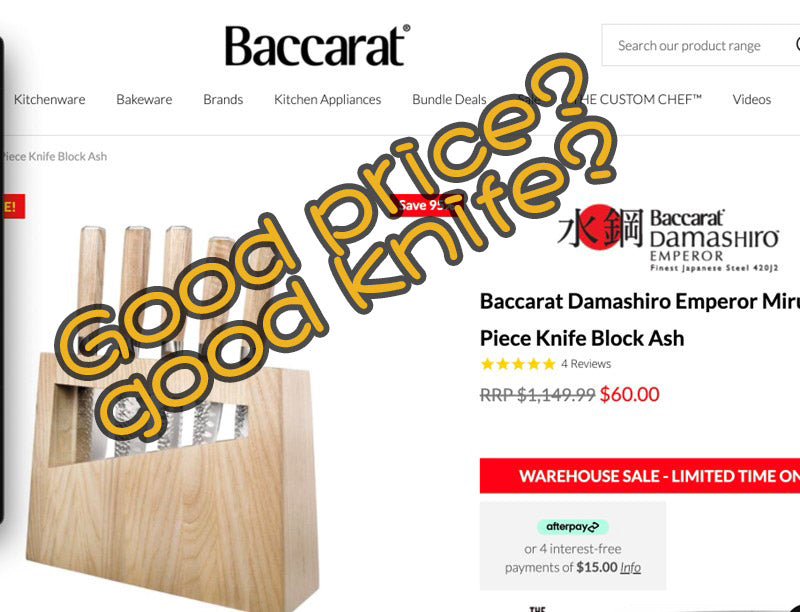Earlier today saw this Baccarat knife set that is on a huge discount. It is listed on Baccarat’s own website, so it is very much a legitimate sale. At first, one would have caught by the huge discount: from $1149.99 down to $60. As an average customer, we can’t really tell if the quality is good or not, but given it is a somewhat well-known brand, that must be good right?

(A Baccarat knife set discounted by 95%!)
In case the link is removed, here is a original post of OzBargain.
Well, we probably have to ask ourselves: what sort of properties that define a “quality knife”? The look? The Damascus? The fancy name “water steel” logo (whatever that means)? The made up “damahiro” word? Ok, let’s read further into its “FEATURES”.

(Description taken from the listing)
Apart from all the marketing nonsense text, one that actually makes half sense is this line: engineered to Rockwell 53.
What is Rockwell Hardness?
The Rockwell scale is a hardness scale based on indentation hardness of a material. (Wikipedia). In a nutshell, higher the hardness, longer the edge holds, and can potentially be sharper (by grinding the edge to an more acute angle). However, Rockwell scales have different ratings. HRA, HRB, HRC, etc. Knives are usually measured under the Rockwell C scale but here it only said Rockwell 53.
Now let’s assume it is HRC 53, does it mean anything? Probably not too much unless we put it into perspective.
- Victorinox, Wustof (DIN 1.4116, HRC 55-56)
- Global (CROMOVA, HRC 56-58)
- Tojiro / Shun (VG10, HRC 60-61)
- Premium Japanese makers (White 2: HRC 60-63, SG2: HRC62-64, ZDP189: HRC 64-66)
You might still wonder, that is the difference between HRC 59 and 60 anyway, it is only 1. Truth is, Rockwell C scale is non-linear, especially in the higher end (HRC 62+). HRC 63 is almost 50% harder than HRC 53, you can read more here.
You see, HRC 53 is not hard enough to be in the mainstream of “good” knives regardless of how epic you can make up the names. It is amongst the lowest and can barely be called steel. I’d be surprised if any serious knife maker from Japan that actually makes anything with this sort of low hardness. With my limited 10 years’ experience in the knife business, I have never seen one.
So, does this line still make sense?
Well, you tell me :)

(A description from the Baccarat Damashiro knife)
To be honest, if you buy a knife based on the look, this is probably a decent buy at $60, since it even comes with a knife block. However, if you are in the camp that is looking to buy a knife that will give you pride and joy in your daily cooking, you should probably look for something else that has at least about HRC 60 in hardness.
Of course, hardness is not the only important aspect, other aspects such as the profile and grind are as important. We will talk about this in later blogs.
To conclude, Rockwell Hardness is a key element of choosing kitchen knives. It is a non-linear scale, 1 HRC difference is quite significant in kitchen knives. Harder the steel, the knife can hold its edge longer but also means it is harder tp sharpen. For anyone who is looking to get into Japanese kitchen knives, one should look for anything between HRC 58 to 62, as it is a good balance between good edge retention and ease of sharpening.

